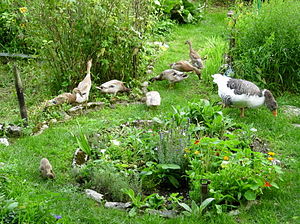Sustainable gardening — also known as permaculture, or permanent agriculture united with permanent culture — came to being as a reaction to issues regarding unsustainable farming practices, the erosion of loam, waste of water sources, as well as a break down in the natural cycle of our environment, amid other things.
 Image via WikipediaSustainable agriculture can be described as a way for man to learn from the natural world in developing biological, workable, edible ecosystems. The thought should be to understand what is learned from the environment and put it to work within your specific landscape, whether you have a small garden or plenty of land.
Image via WikipediaSustainable agriculture can be described as a way for man to learn from the natural world in developing biological, workable, edible ecosystems. The thought should be to understand what is learned from the environment and put it to work within your specific landscape, whether you have a small garden or plenty of land.Permaculture involves taking a look at the whole system and how every part relates to all the other pieces. It is usually about finding then fixing the weak links or problems in a very sustainable way without the use of fossil fuels. Diversity along with minimal waste are of the essence in sustainable gardening.
Permanent agriculture, or sustainable gardening, uses a zone concept. The greater amount of activity that an area involves, the closer to your house that zone ought to be. For instance, Zone 1 is closest to the home and therefore should contain herbs and vegetables which need to be harvested more often. The zone that’s farthest away, based on the dimensions of the land that you’re working, should be fruit trees or other plants that require less maintenance.
If you should look at a forest, you may notice the “stacking” done in nature. This may be intentionally mirrored by people. The stacking starts with tall fruit trees which forms the cover, for dwarf trees, to shrubs, to smaller plants, then root vegetables, and lastly right down to ground cover plants like strawberries. From imitating the natural world, one may form guilds, which are combinations within the stacking technique which work effectively together. As an example, Native Americans planted a guild of corn, squash, and beans.
Sustainable gardening additionally asks plants and trees to provide more than one role. For instance, an apple tree gives:
* shade for smaller, shade-loving crops,
* shade for its roots, meaning a smaller amount of water will be necessary,
* a resting or nesting site used by birds, who in return replenish the earth,
* fruit meant for humans and animals to consume,
* dead leaves that fall to the ground and decompose, helping to replenish the soil,
* branches for fire
 Image via WikipediaYou may want to give some serious thought to tearing out your wasteful water-consuming lawn to grow food designed for human and/or wildlife consumption. Conventional ways of growing are usually fairly labor-intensive and also may require chemicals to maintain them. However, when a sustainable garden landscape gets going and starts to support itself it becomes a far less time-consuming way to garden. And it sets the crops up with a way more natural method of nourishing themselves. Following sustainable gardening practices can also be a means to close the ecosystem loop and become more sustainable.
Image via WikipediaYou may want to give some serious thought to tearing out your wasteful water-consuming lawn to grow food designed for human and/or wildlife consumption. Conventional ways of growing are usually fairly labor-intensive and also may require chemicals to maintain them. However, when a sustainable garden landscape gets going and starts to support itself it becomes a far less time-consuming way to garden. And it sets the crops up with a way more natural method of nourishing themselves. Following sustainable gardening practices can also be a means to close the ecosystem loop and become more sustainable.Hope that sheds some light on the subject!
Rose.
P.S. We have more info and resources for learning more about sustainable gardening on our main website. And for weekly sustainable gardening tips and updates, subscribe to our free weekly Sustainable Gardening News!

No comments:
Post a Comment